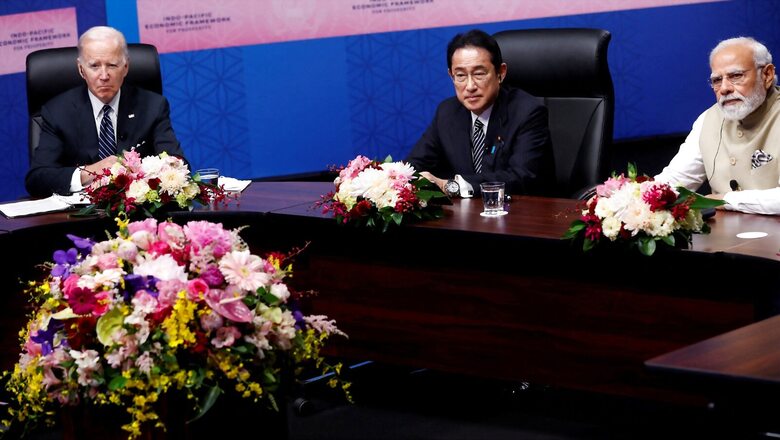
views
India has made a strong strategic statement and commitment, by joining the newly announced 13 nation Indo-Pacific Economic Framework (IPEF) and the announcement of the Quad’s new initiative to combat illegal fishing in the Indo-Pacific region under the Indo-Pacific Maritime Domain Awareness (IPDMA). These are two positive outcomes of the second Quad leaders’ summit held in Tokyo, building on the first summit in Washington, which resulted in charting an agenda and giving direction to the Quad.
Despite the fact that China has not been named, the goal of both of these initiatives is clear: to counter China’s rise and disregard for international law and rules-based order, which has shaken the region. China’s reaction was swift, and it slammed it even before it was officially launched, declaring it as doomed to fail.
India is targeting multiple objectives.
One, India is telling China that it’s game on – in the strategic competition that China has initiated. India had tried to work a modus vivendi with China after the Doklam stand-off with the two informal summits that Prime Minister Narendra Modi initiated with Chinese President Xi Jinping. But this was rebuffed violently by China with the Galwan clash in June 2020 that resulted in the killing of 20 Indian soldiers and 45 Chinese troops, after China intruded into Indian territory in multiple places in India’s Union Territory of Ladakh.
India has repeatedly stated that relations between the two countries cannot be normal with border problems. New Delhi appears to be avoiding a war until imposed on it, deferring the resolution of the border as it builds its economic and military capabilities, and partnerships to strengthen itself. India deepening its relations with the Quad countries and its commitment towards the Quad is an important part of it. As India’s External Affairs Minister S. Jaishankar recently stated, India’s decisions are made by balancing its values and interests, rather than being cynical and transactional.
Deepening commitment to the Quad and joining the IPEF are deliberate decisions based on an assessment that China is not interested in peaceful relations with India. China is unlikely to work towards resolving the current border incursion, let alone the unresolved boundary issue, with China occupying nearly 40,000 square kilometres of Indian territory and claiming the entire Indian state of Arunachal Pradesh. Although it is said that nothing is permanent in international relations, India appears at a point of no return in its relations with China.
Two, it demonstrates India’s commitment to the region’s countries, particularly ASEAN. China’s illegal fishing has no direct impact on India, nor does it face any intrusion into its exclusive economic zone (EEZ) by Chinese fishing trawlers, at least not yet. However, China uses its massive fishing fleet not only to fish illegally in the territorial waters and EEZs of South East Asian countries, but also to assert its territorial claims. China has an armed fishing militia that is armed and funded by the People’s Liberation Army and is integrated with its commercial fishing fleet. It goes without saying that the Quad’s anti-illegal fishing initiative is aimed squarely at China. India, which has increased its naval presence in the South China Sea, is diving into the contested waters on the side of the South East Asian countries.
Three, to the democratic world at large – that India is ready to collaborate with a grouping of like-minded countries to preserve the rules based order that has kept global peace since the Second World War and brought economic growth and prosperity. This is a departure from India’s historic stance on forming groups targeting third countries.
Critics of the IPEF and the IPDMA argue that there is nothing tangible. The IPEF does not increase market access nor reduce tariff barriers, and there is no clarity on how the Quad will counter illegal fishing. While the argument is correct, it overlooks the fact that the initiatives are strategic in nature. The framework is pillared on trade, supply chain, clean energy, decarbonization, and infrastructure, and tax and anti-corruption. Keywords like – inclusive, free and fair, sustainable and durable infrastructure, transparency, resilient supply chains, access to critical minerals, concessional finance, fair competition and anti-bribery, are squarely to counter China’s trade practices, and its Belt and Road Initiative, that is a debt trap, especially for small nations ruled by strongmen who China influences with its money power.
The IPEF is not intended to provide immediate economic benefits by increasing market access and lowering tariffs, but rather to form a coalition of the willing to set the rules of the game in accordance with international law. The fact that major ASEAN nations, which had been wary of the Quad, have joined the IPEF attests to this. The framework also gives meaning to ASEAN centrality, which the Quad frequently emphasises. It also demonstrates that China’s policies have alienated the previously friendly ASEAN. Although the IPEF is an American initiative, it is likely that the Quad nations were involved in its conceptualization, an argument bolstered by the fact that it was called a notable initiative on the sidelines of the Quad leaders’ summit by India’s foreign minister S. Jaishankar. As a result, the IPEF appears to be a Quad initiative that was made palatable in order to bring these countries together.
India, which wants to play a leading role in shaping the region, sees the IPEF as a regional rule-making body, similar to the Quad, which it sees as a necessity given the failure of existing multilateral institutions. The lack of a provision to increase market access and lower tariffs also aided the decision to be part of it, as both India and the US are wary of multilateral trade agreements and prefer bilateral trade agreements. Given India’s concerns about cross-border data flows and data localization which the United States intends to pursue as part of the framework, India becoming part of it demonstrates the comfort level and confidence in working with the United States and seeing the larger strategic benefits. India is also eyeing the benefits of decoupling from China, which is what resilient supply chains alludes to.
From India, a clear strategic direction is visible. In pursuit of its national interest, it sees value in the Quad and is betting big on it. It would have been difficult to imagine India participating in an American-led economic initiative just a few years ago. It now sees it as beneficial and complementary to its own Act East and Neighbourhood First policies. Furthermore, it is doing so with confidence and is not allowing other countries to have a veto over its decisions, which has previously stifled bold decision-making. India is unequivocally telling China that the bilateral relations are damaged beyond repair.
Yusuf T. Unjhawala is editor of Defence Forum India and Adjunct Scholar at the Takshashila Institution. The views expressed in this article are those of the author and do not represent the stand of this publication.
Read all the Latest News , Breaking News , watch Top Videos and Live TV here.

















Comments
0 comment